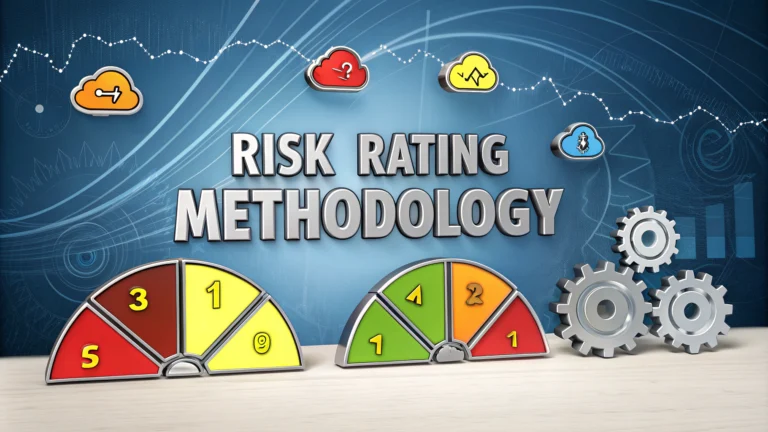Risk rating methodologies in penetration testing help organizations quantify and prioritize security vulnerabilities based on their potential impact and likelihood of exploitation.
Security teams use these ratings to allocate resources effectively and address the most critical weaknesses first in their systems and applications.
A structured risk rating approach ensures consistent evaluation across different penetration tests and enables clear communication of findings to stakeholders.
Common Risk Rating Systems
- CVSS (Common Vulnerability Scoring System) – Industry standard scoring from 0-10
- DREAD – Damage, Reproducibility, Exploitability, Affected users, Discoverability
- OWASP Risk Rating – Based on likelihood and impact factors
Components of Risk Assessment
Each vulnerability discovered during penetration testing should be evaluated across multiple dimensions:
| Factor | Description |
|---|---|
| Technical Impact | Data exposure, system compromise potential |
| Business Impact | Financial loss, reputation damage, regulatory compliance |
| Exploitation Difficulty | Skills and resources needed to exploit |
| Attack Vector | Local vs remote access requirements |
Using CVSS Effectively
CVSS provides a standardized approach to scoring vulnerabilities:
- 0.0-3.9: Low severity
- 4.0-6.9: Medium severity
- 7.0-8.9: High severity
- 9.0-10.0: Critical severity
Practical Implementation Tips
- Document clear criteria for each risk level
- Consider both technical and business context
- Maintain consistency across assessments
- Review ratings with stakeholders
- Update methodology based on feedback
Risk Rating Template Example
| Rating Level | Action Required | Timeframe |
|---|---|---|
| Critical | Immediate remediation | 24-48 hours |
| High | Prioritized fix | 1-2 weeks |
| Medium | Scheduled remediation | 1-3 months |
| Low | Fix as resources allow | 3-6 months |
Documentation Requirements
Each vulnerability report should include:
- Clear risk rating with justification
- Detailed technical description
- Steps to reproduce
- Potential impact analysis
- Remediation recommendations
Moving Forward with Risk Management
Regular review and updates of your risk rating methodology ensure it remains aligned with your organization’s security objectives and industry standards.
Contact industry bodies like FIRST (www.first.org) or OWASP (www.owasp.org) for additional guidance on risk rating frameworks.
Continuous Improvement Process
Organizations should establish feedback loops to refine their risk rating methodologies:
- Collect data on remediation effectiveness
- Track time-to-fix metrics
- Monitor false positive rates
- Analyze trending vulnerability types
- Update scoring criteria based on new threats
Integration with Security Programs
DevSecOps Implementation
Risk ratings should inform automated security gates and deployment decisions within the CI/CD pipeline.
Vulnerability Management
Align penetration testing risk ratings with broader vulnerability management processes for consistent prioritization.
| Program Element | Integration Point |
|---|---|
| SAST/DAST | Automated severity mapping |
| Bug Bounty | Reward structure alignment |
| Incident Response | Escalation triggers |
Building a Risk-Aware Culture
Effective risk rating systems contribute to organizational security awareness:
- Train teams on risk assessment methodology
- Share success metrics and improvements
- Encourage cross-functional risk discussions
- Promote transparent reporting practices
Securing the Future Through Strategic Risk Assessment
Risk rating methodologies serve as the foundation for informed security decisions. Organizations must continually evolve their approach to match emerging threats and changing business needs.
Success depends on consistent application, clear communication, and alignment with security objectives. Regular methodology reviews and stakeholder engagement ensure sustainable risk management practices.
- Maintain rating system flexibility
- Adapt to new attack vectors
- Scale with organizational growth
- Support business objectives
FAQs
- What is a Risk Rating Methodology in penetration testing?
A Risk Rating Methodology is a systematic approach to evaluate and quantify security vulnerabilities discovered during penetration testing, typically considering factors like impact severity, likelihood of exploitation, and potential business consequences. - What are the common components of risk ratings in penetration testing?
Common components include threat likelihood, impact severity, exploitability, affected users/systems, technical impact, business impact, and existing security controls. - How is CVSS (Common Vulnerability Scoring System) used in risk rating?
CVSS provides a standardized framework for scoring vulnerabilities on a scale of 0-10, considering base metrics (inherent characteristics), temporal metrics (time-dependent factors), and environmental metrics (implementation-specific factors). - What’s the difference between qualitative and quantitative risk ratings?
Qualitative ratings use descriptive terms (Low, Medium, High, Critical), while quantitative ratings assign numerical values and specific metrics to vulnerabilities. - How do you prioritize vulnerabilities using risk ratings?
Vulnerabilities are prioritized based on their combined risk score, considering factors like business impact, ease of exploitation, and remediation effort, typically categorized as Critical, High, Medium, or Low priority. - What role does business impact play in risk rating?
Business impact assessment evaluates potential financial losses, regulatory compliance violations, reputational damage, and operational disruptions that could result from vulnerability exploitation. - How frequently should risk ratings be reviewed and updated?
Risk ratings should be reviewed when new threats emerge, after significant system changes, when new vulnerabilities are discovered, and at least quarterly for critical systems. - What are the key factors in determining exploitation likelihood?
Key factors include technical complexity of exploitation, required access levels, availability of exploit code, authentication requirements, and presence of security controls. - How do compliance requirements affect risk ratings?
Compliance requirements influence risk ratings by adding regulatory impact considerations, mandatory security controls, and specific scoring criteria based on industry standards (PCI DSS, HIPAA, etc.). - What documentation should accompany risk ratings in pentest reports?
Documentation should include detailed vulnerability descriptions, proof of concept, technical impact, business impact, remediation recommendations, and methodology used for risk calculation.







